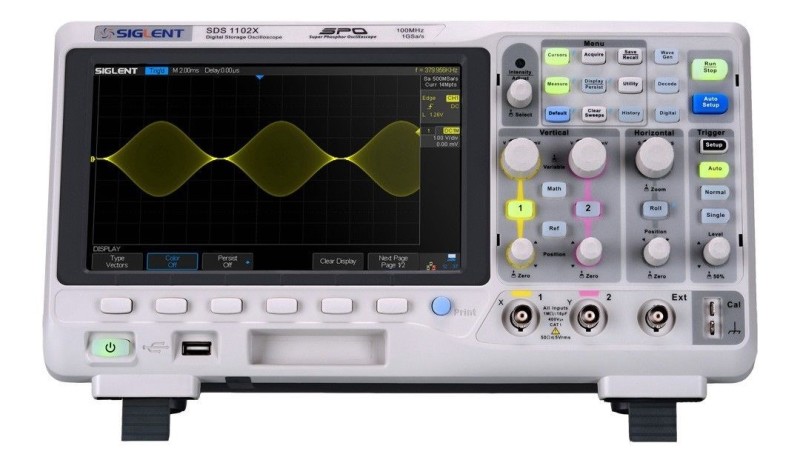Review: Siglent oscilloscope SDS1102X
August 12, 2016
on
on

After the review of a Siglent SDG 830 function generator a few weeks ago we will now continue with an oscilloscope of the same brand. An oscilloscope in particular is an indispensable instrument for the electronics enthusiast to visualize the motions of the electrons in a circuit.
Before we take a look at the instrument itself, I would like to say something about the characteristics of an oscilloscope for 'small users'. What do you really need for your daily tasks? Even the cheapest models from Chinese manufacturers already have a sample rate of 500 MS/s or 1 GS/s, much more than what the typical electronics engineer needs. More important is the input bandwidth, which is an indication of the quality of the analog input stage, which, for example, could be 50 or 100 MHz. Most electronic engineers work on circuits with frequencies up to a few megahertz and then a simple USB scope with a sample rate of 100 MS/s and an input bandwidth of 10 MHz is already more than sufficient.
That puts the sample rate and bandwidth into perspective. What is very important for a stand-alone scope, in addition to all kinds of technical capabilities, is the quality of the screen and the ease of use. With these there are often big differences, which are not necessarily related to the price of the instrument. I'm familiar with several expensive scopes from the big brands where the operation gives you goose bumps and you are forever searching for a setting or have to resort to reading the manual. Unfortunately you cannot usually try out a scope in a shop before you purchase it, so you then have to rely on reviews and the experience of others.
So, now it has become time to take a look at the SDS1102X. This is a two-channel instrument from the middle of the range from Siglent, with a price that is just a little over €500 for Elektor members. The sample rate is up to 1 GS/s (500 MS/s when using 2 channels) and the bandwidth is 100 MHz, very respectable characteristics for this price. The signal memory of the SDS1102X is 14Mpts in length for both channels together. (7 MPts/channel when using 2 channels). When unpacking the scope you immediately notice that scope has a sturdy feel and has a considerable weight. At 8 inch, the wide-screen LCD display is quite large and also occupies most of the real estate of the front panel. The operating panel is quite conveniently arranged and has separate knobs for the vertical settings of the two channels. Along the bottom of the screen are a number of menu buttons (soft keys).
Before we take a look at the instrument itself, I would like to say something about the characteristics of an oscilloscope for 'small users'. What do you really need for your daily tasks? Even the cheapest models from Chinese manufacturers already have a sample rate of 500 MS/s or 1 GS/s, much more than what the typical electronics engineer needs. More important is the input bandwidth, which is an indication of the quality of the analog input stage, which, for example, could be 50 or 100 MHz. Most electronic engineers work on circuits with frequencies up to a few megahertz and then a simple USB scope with a sample rate of 100 MS/s and an input bandwidth of 10 MHz is already more than sufficient.
That puts the sample rate and bandwidth into perspective. What is very important for a stand-alone scope, in addition to all kinds of technical capabilities, is the quality of the screen and the ease of use. With these there are often big differences, which are not necessarily related to the price of the instrument. I'm familiar with several expensive scopes from the big brands where the operation gives you goose bumps and you are forever searching for a setting or have to resort to reading the manual. Unfortunately you cannot usually try out a scope in a shop before you purchase it, so you then have to rely on reviews and the experience of others.
So, now it has become time to take a look at the SDS1102X. This is a two-channel instrument from the middle of the range from Siglent, with a price that is just a little over €500 for Elektor members. The sample rate is up to 1 GS/s (500 MS/s when using 2 channels) and the bandwidth is 100 MHz, very respectable characteristics for this price. The signal memory of the SDS1102X is 14Mpts in length for both channels together. (7 MPts/channel when using 2 channels). When unpacking the scope you immediately notice that scope has a sturdy feel and has a considerable weight. At 8 inch, the wide-screen LCD display is quite large and also occupies most of the real estate of the front panel. The operating panel is quite conveniently arranged and has separate knobs for the vertical settings of the two channels. Along the bottom of the screen are a number of menu buttons (soft keys).
Read full article
Hide full article



Discussion (0 comments)